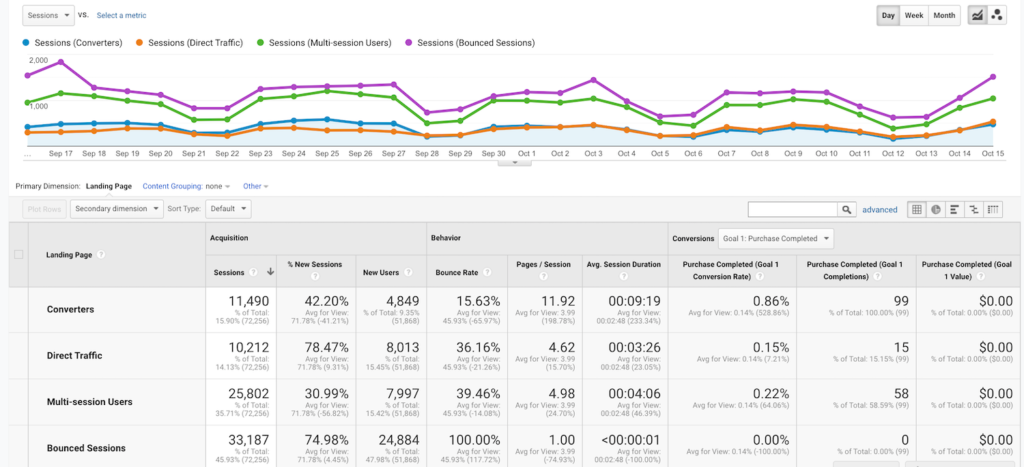Discover the Limitations of Google Analytics Goals: Revealing the Information Kind That Remain Untrackable
As companies progressively depend on data-driven decision-making, comprehending the limitations of devices like Google Analytics ends up being paramount. While Google Analytics Goals offer important understandings into customer communications, there exist information kinds that elude tracking, positioning obstacles to an extensive understanding of individual behavior. These untrackable information types question about the accuracy and completeness of the analytics information that organizations greatly trust for their digital techniques. Curious to uncover the concealed dead spots in your data evaluation procedure?
Insufficient Customer Trip Tracking
Incomplete user journey tracking within Google Analytics can impede the capacity to properly assess customer behavior. When the user trip is not fully tracked, there are spaces in the data that avoid a detailed understanding of just how users interact with a site. This lack of understanding can cause missed out on chances for optimization and improvements to the user experience.
One common concern with insufficient customer trip tracking is the inability to see the full course that customers take in the past finishing an objective or leaving the site. Without this info, it is testing to recognize where individuals may be experiencing challenges or friction points that stop them from transforming. Additionally, insufficient tracking can cover the impact of certain advertising efforts or site changes on customer actions.
To address this restriction, it is vital to establish correct tracking devices within Google Analytics to catch the entire individual trip. This might entail establishing occasion monitoring, goal funnels, or using devices like Google Tag Supervisor to ensure that no important communications go unrecorded. By getting an extensive sight of the individual journey, internet site proprietors can make even more educated decisions to improve user interaction and drive conversions.
Acknowledgment Difficulties
Navigating through attribution obstacles in Google Analytics needs an extensive understanding of how various touchpoints add to the general conversion process. Acknowledgment obstacles emerge from the complexity of modern-day consumer trips, where users interact with several channels prior to converting. Google Analytics gives different acknowledgment models like very first touch, last touch, and straight, each supplying a different perspective on how credit rating is designated to touchpoints along the conversion course. These designs might not always accurately show the real influence of each touchpoint on the conversion.
One usual acknowledgment difficulty is the difficulty in associating conversions to the appropriate source, specifically in instances where customers communicate with multiple networks before transforming. Furthermore, cross-device monitoring postures another acknowledgment obstacle, as individuals frequently switch between gadgets throughout their trip, making it challenging to track their communications seamlessly.
Offline Conversions
Offered the challenges linked with attributing conversions precisely in online channels, the measurement of offline conversions offers a significant possibility for marketing experts seeking an extra comprehensive understanding of their clients' trip. Offline conversions refer to activities that clients absorb the real world, such as making acquisitions in brick-and-mortar shops or over the phone, attending occasions, or involving with published products - what data is google analytics goals unable to track. These conversions are vital for services that operate both online and offline, as they supply beneficial insights right into the effectiveness of advertising projects throughout various touchpoints
Tracking offline conversions generally positioned a significant difficulty for marketing professionals, as it was testing to attach these actions back to particular online interactions precisely. Nevertheless, with improvements in modern technology, such as the combination of CRM systems, one-of-a-kind identifiers, and promo code codes, companies can currently link the void in between online and offline data to obtain an extra holistic view of client habits. By properly gauging offline conversions, marketing experts can maximize their techniques, designate sources a lot more efficiently, and inevitably enhance the overall customer experience.
Cross-Device Monitoring
Cross-device monitoring plays an important role in comprehending the interconnected nature of consumers' electronic interactions throughout numerous devices. In today's omnichannel globe, where individuals effortlessly change in between tablets, desktop computers, and mobile phones, tracking their actions throughout these tools is vital for online marketers to obtain an extensive view of their client journey.

Additionally, personal privacy problems and laws such as GDPR and CCPA have even more difficult cross-device tracking. With users requiring even more control over their information and raised restrictions on monitoring modern technologies, marketing professionals have to locate privacy-compliant and innovative ways Your Domain Name to connect customer communications throughout devices.
Dynamic Content Interaction
Recognizing customer interaction with dynamic web content is crucial in maximizing electronic advertising pop over to this web-site and marketing strategies for enhanced target market interaction. Dynamic content refers to site elements that alter based on individual behavior, preferences, or various other aspects, supplying a personalized experience. Tracking individual interactions with dynamic web content postures difficulties for conventional analytics tools like Google Analytics.
While Google Analytics can track basic interactions like clicks and web page sights, it may have a hard time to capture even more nuanced interactions within dynamic content. what data is google analytics goals unable to track. Metrics such as time invested on details vibrant elements, float actions, or interactions within pop-ups are frequently not easily quantifiable using typical tracking methods. This restriction hinders online marketers' ability to totally realize how individuals are engaging with vibrant content and tailor their strategies accordingly

Conclusion
To conclude, Google Analytics objectives have limitations in tracking insufficient individual journeys, connecting conversions properly, recording offline conversions, tracking cross-device interactions, and measuring vibrant content engagement. These restraints highlight the relevance of exploring additional tracking methods and devices to gain a more extensive understanding of user behavior and conversions beyond what Google Analytics can my link offer.
While Google Analytics Goals offer important understandings into user interactions, there exist data kinds that elude monitoring, positioning challenges to a comprehensive understanding of user behavior.Insufficient customer journey monitoring within Google Analytics can prevent the capacity to precisely assess individual actions. When the user journey is not fully tracked, there are spaces in the data that prevent an extensive understanding of exactly how users communicate with a site.One typical problem with incomplete user journey monitoring is the inability to see the complete course that users take before finishing an objective or leaving the site. By gaining an extensive view of the customer trip, web site owners can make more enlightened decisions to boost user involvement and drive conversions.